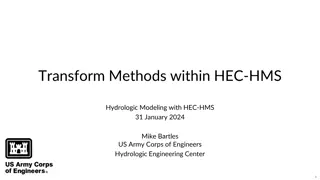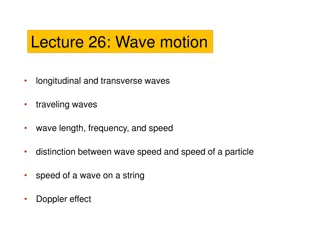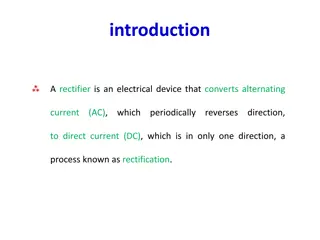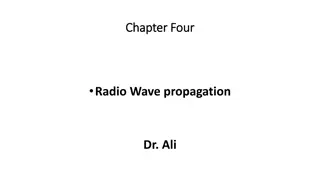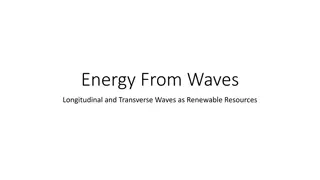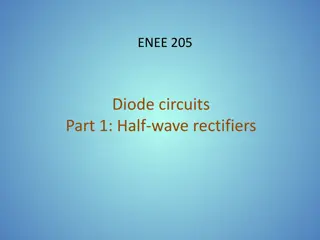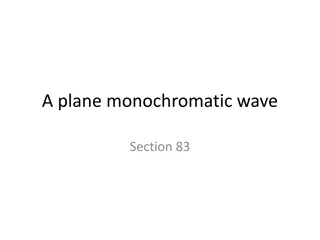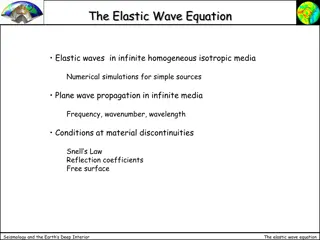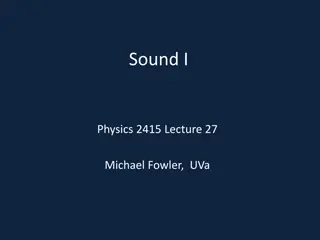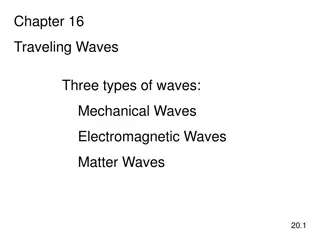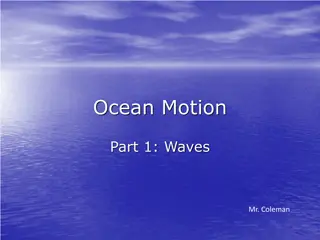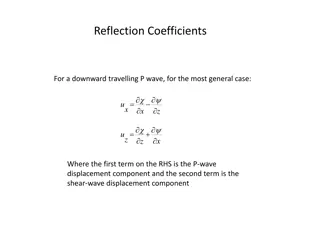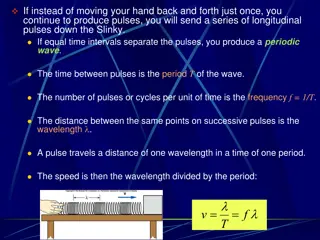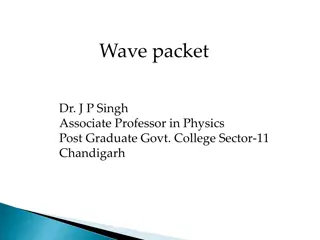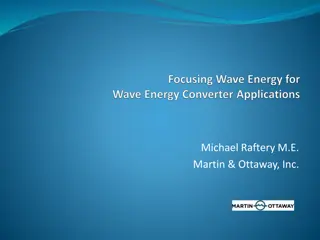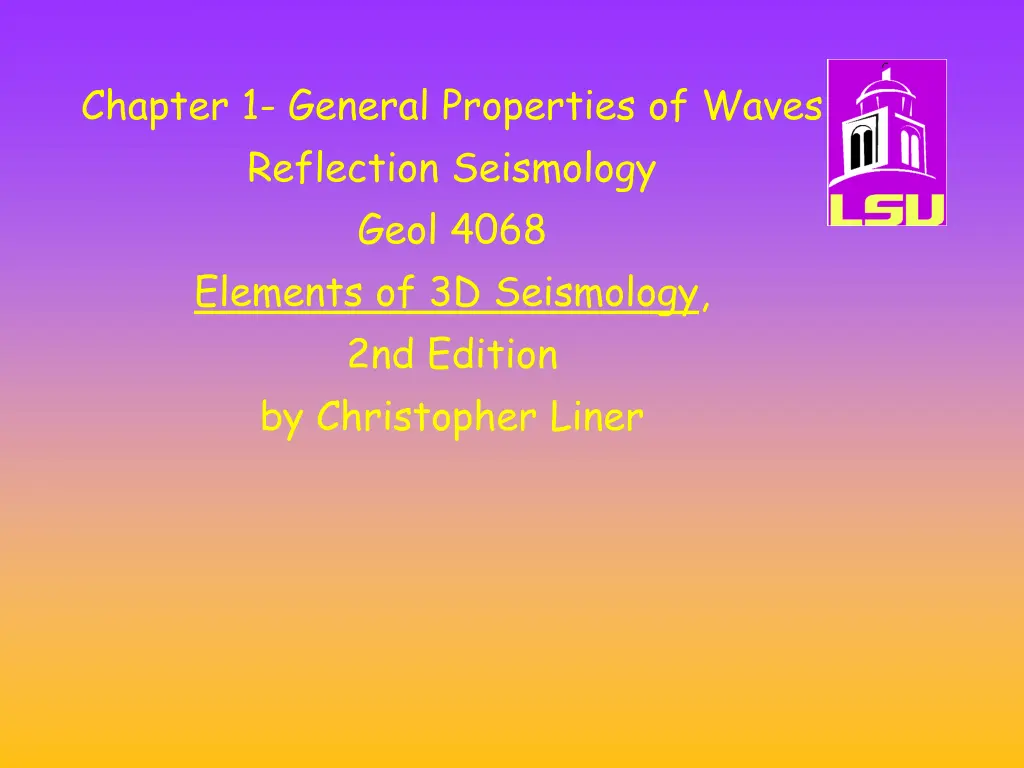
Exploring General Properties of Waves in Seismology and Geology
Dive into the fundamental aspects of waves in reflection seismology and geology, covering topics such as wave descriptions, particle motion, wavefront properties, and the effects of anisotropy on seismic waves. Discover the mechanical definitions and physical assumptions underlying wave behavior, including insights into homogeneous and anisotropic mediums. Explore the implications of anisotropy on seismic wave phenomena through engaging resources like Ed Garnero's work on shear wave splitting.
Download Presentation

Please find below an Image/Link to download the presentation.
The content on the website is provided AS IS for your information and personal use only. It may not be sold, licensed, or shared on other websites without obtaining consent from the author. If you encounter any issues during the download, it is possible that the publisher has removed the file from their server.
You are allowed to download the files provided on this website for personal or commercial use, subject to the condition that they are used lawfully. All files are the property of their respective owners.
The content on the website is provided AS IS for your information and personal use only. It may not be sold, licensed, or shared on other websites without obtaining consent from the author.
E N D
Presentation Transcript
Chapter 1- General Properties of Waves Reflection Seismology Geol 4068 Elements of 3D Seismology, 2nd Edition by Christopher Liner
Outline-I General Properties of Waves Physical Assumptions Wave descriptions Body waves Surface waves Particle motion
Outline-II General Properties of Waves Wave descriptions Graphical Mathematical
Outline-III General Properties of Waves General theorems and principles Reciprocity Theorem Fermat s Principle Snell s Law, Conservation of ray parameter, critical angle Huygen s Principle
Outline-I General Properties of Waves Mechanical definition of a wave Physical Assumptions Wave descriptions Body waves Surface waves Particle motion
Mechanical definition of a wave Physical Assumptions t3 Homogeneous, isotropic medium cylindrical wavefronts-- rays are at right angles to the wavefronts t2 t1
Mechanical definition of a wave Physical Assumptions Anisotropic-- rays are not at right angles to the wavefronts! Anisotropy can be as much as 10-20% t3 t2 t1
What effect does severe anisotropic cause on seismic waves? See movie by Ed Garnero: http://en.wikipedia.org/wiki/Shear_wave_splitting
General Properties of Waves Mechanical definition of a wave Physical Assumptions Wave descriptions Body waves Surface waves Particle motion
Body Waves Direction of particle displacement Direction of propagation of the body wave Y Direction of particle displacement X Z Direction of propagation of the body wave Direction of particle displacement Direction of propagation of the body wave
Body Waves - do not require a boundary to travel Direction of particle displacement SV Direction of propagation of the body wave Y Direction of particle displacement X SH Z Direction of propagation of the body wave Direction of particle displacement P Direction of propagation of the body wave
General Properties of Waves Mechanical definition of a wave Physical Assumptions Wave descriptions Body waves Surface waves Particle motion
Surface Waves When body waves (P & SV) traveling through rock reach the interface below a fluid (e.g., atmosphere or water) complex particle motions in the rock are generated, such as Rayleigh waves (air/rock) or Stonely waves (solid /rock). These motions are retrograde elliptical at shallow depths to prograde elliptical at increasing depths. SH waves can be trapped through multiple internal reflections in layers near the surface and these can generate Love waves X
Surface Waves X X Amplitude of Rayleigh wave decays with depth Z Adapted from Aki and Richards, 2002, p. 156
General Properties of Waves Mechanical definition of a wave Physical Assumptions Wave descriptions Body waves Surface waves Particle motion
Particle Motion --Image 1
Particle Motion --Image 2
Particle Motion --Image 3
Particle Motion --Image 4
Particle Motion --Image 5
Outline-II General Properties of Waves Wave descriptions Graphical Mathematical
Graphical- periodic waves Fixed time particle velocity V (m/s) distance * Displacement/velocity/acceleration (m;m/s;m/s^2) * Fixed position
Graphical Fixed time particle velocity V.s/m distance * particle velocity V.s/m * Fixed position
Mathematical Temporal (f---Hz) frequency = 1/period; units of (1/s) Angular frequency = 2 f Spatial ( ---m) Wavenumber(k) = 1/wavelength; units of (1/m) Angular wavenumber= 2 Temporal and Spatial mixed velocity (m/s) = frequency * wavelength
phase Spatial domain Phase angle = distance ahead or behind normalized to circular wavelength 2 + cos( ) x phaseangle Temporal domain 2 + Phase angle = time earlier or later normalized to circular frequency cos( ) t phaseangle ?
phase Spatial domain Phase angle = distance ahead or behind normalized to circular wavelength 2 + cos( ) x phaseangle Temporal domain 2 T Phase angle = time earlier or later normalized to circular frequency + cos( ) t phaseangle
Mathematical Representation Signal power can be measured in a relative scale known as decibels: Decibels: B = log of ratio of powers (energies) dB = 10 log (P1/P2) e.g., P1 =100, P2 = 10 then, P1/P2 = 10 10.log10 = 10 dB = 10 e.g., P1 = 4, P2 = 1 then, P1/P2 10 log4 = 6 (in dB) = 4 ; (log4 = 0.6) octave = f, 2f, 4f, 8f
As humans hear Range of octaves = log base2(20000Hz/20Hz) (= ln (20000/20) / ln(2) = 9.96) E.g., if human range of hearing were 20 Hz (min.) to 80 Hz (max.) Octave range, (# octaves) = ln(80/20) / ln(2) 20 * 2 ^a = 80 (max) a = 2
Mathematical Representation Geometric Spreading seismic amplitude is proportional to the Energy ^ 0.5 of the wave at the moment or place energy density or concentration on a spherically expanding wavefront is proportional to 1/(4. .r^2) amplitude is proportional to 1/((4* )^0.5*r) where r is the distance traveled by a ray along its path
Mathematical Geometrical Spreading e.g., using cubes Energy density= energy/Area 2x 2x Area 1 2x Energy density in Area2/Energy density in Area 1 = Area1/Area2
Mathematical Geometrical Spreading 2x r1=2^0.5*x 2x Longer side = 2x(r2/r1) r2 TOP VIEW=SIDE VIEW
Mathematical Geometrical Spreading Area2/Area1 = (r2/r1)^2 Distance r1 = X.2^0.5 r1 Area 1 r2
Mathematical Representation Geometric Spreading with a CUBE By similarity of triangles: r2/r1 = length of longer side/2x length of longer side = (r2/r1)*2x short side =2x Area1 = 4 * x^2 Area 2 = (r2/r1)^2 *4*(x^2) Area1/Area2 = (r2/r1)^2
Mathematical Representation Geometrical Spreading Energy density ratios = (r1/r2) ^2 r1 Area 1 r2 Amplitude ratios = r1/r2
General Properties of Waves General theorems and principles Reciprocity Theorem Fermat s Principle Snell s Law, Conservation of ray parameter, critical angle Huygen s Principle
Reciprocity Theorem (e.g.,Aki and Richards, 2002, p. 24) Corollary: Ground velocities measured by interchanging source and receivers are indistinguishable
Reciprocity Theorem * time
Reciprocity Theorem * time time =
Reciprocity Theorem: Assumption of isotropy *
General Properties of Waves General theorems and principles Reciprocity Theorem Fermat s Principle Snell s Law, Conservation of ray parameter, critical angle Huygen s Principle
Fermats Principle The path a wave travels will always be that which takes the least amount of time to go from the source to a particular receiver
General Properties of Waves General theorems and principles Reciprocity Theorem Fermat s Principle Snell s Law, Conservation of ray parameter, critical angle Huygen s Principle
Snells Law: Consequence of Fermat s Principle Ratio of the sines of the angles of incidence and reflection or refraction are proportional to the ratios of the velocities of the waves in their respective media
Snells Law Angle of incidence V1 V1<V2 V2 Angle of refraction V2
Snells Law Angle of incidence V1 V1=V2 V2 Angle of refraction
Snells Law Angle of incidence V1 V1>V2 V2 Angle of refraction
Snells Law Angle of incidence Angle of reflection V1 V1<V2 Angle of refraction transmitted ray V2 V2
Snells Law Angle of incidence = critical angle V1 Angle of refraction = 90 degrees V1<V2 V2 V2


